Yesterday you saw how our board and batten project came out for the Pinterest Challenge, so today we’re back with the full tutorial shebang. And hold onto your safety goggles, it’s 2,000 words long. But don’t let all the words fool you, we’d say that this was one of the biggest bang-for-you-buck / most fool-proof ways to make an easy upgrade that we’ve encountered in a while. Wow, just realized I’m five sentences into this and I’ve already said “bang” twice. Not sure if that’s a good sign or what…
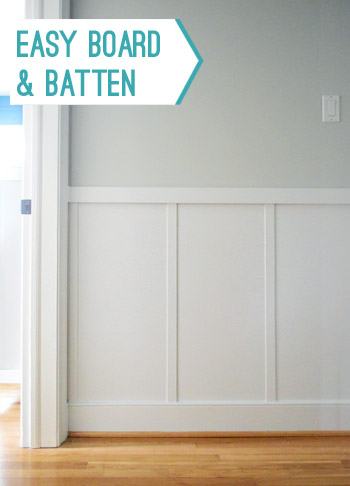
We had long known that adding some sort of molding feature to our hallway was in our future… and now we’re just kicking ourselves for waiting so long. It cost us a mere $57 for the materials (we did buy a tool on top of that, but we’ll get to that in a second) and it only took a few hour-or-two-long work periods over the course of 6 days (including some break days for paint-curing) to finally bring some oomph to our boring hall. So anyone who’s looking to tackle this on nights and weekends could hopefully do it within a week since each step only took a few hours and could be spaced out across each evening.
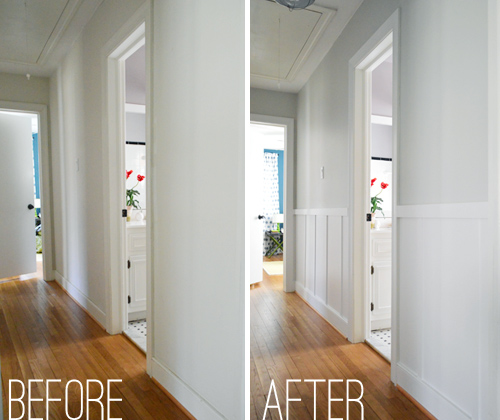
Planning Our Board & Batten
We were inspired by a few other tutorials – like Ana’s, Kate’s, Sarah’s, and Emily’s – and took pieces and parts of each to figure out what worked best for us. So our tutorial below may not be exactly what your space needs, but between the lot of us there should be a fitting solution in there! Let’s just say that we learned that there are many different ways that you can approach board and batten, so a lot is about personal preference, what suits your home, etc.

As for our approach, there are a few things to note upfront:
- We did not add any “board” to the wall – i.e. large flat panels. Since our walls are smooth (not textured) we just used the existing drywall as the backdrop for our vertical battens. Once everything was painted it all looked seamless and gleaming, just like a board would have looked. But if you have textured walls, check out Kate’s tutorial above.
- We used our existing baseboards. Why? Because it was easier – and you know we love to use what we have. Simply by choosing battens that were thinner than our baseboards, we could keep them in place and work with them (saving us time and money). But if you can’t or don’t want to take this approach, both Ana and Kate’s tutorials above talk about replacing the baseboard.
Oh, and if you’re not the word-reading type we made two videos of the process for you (one for the building portion and one for the finishing). So here’s how it all went down when it came to installing the rails and battens (including tips for how to keep the boards level, how to space them out, how to keep them from bowing too far from the walls, etc).
And here’s how we finished everything (including how we filled the nail holes, how I cut in without taping off, and a bunch of other stuff that we shoved in there):
And fret not if you can’t watch the videos (if, say, you’re at work) – we broke down all the steps with photos and descriptions right here (note: watching them later if you’re planning to tackle this might simplify things a lot – I always think videos make things less intimidating).
Measuring & Shopping For Materials
To start, we measured the space and planned our materials. My graph-paper sketch was probably overkill, but it made me feel better. It helped us plan how many boards we needed for the top rail and ledge, as well as count how many battens (the vertical strips) we might need.
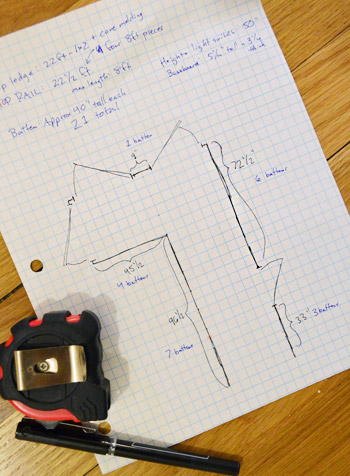
Next up was a supply run. We had most of what we needed on hand, so the only four items that we ended up purchasing are pictured below (the nail gun being a belated birthday gift from my sweet wife who was just waiting for me to pick out the one I wanted). Update: The nail gun shown below is no longer sold, but we’ve switched over to using this compressor-less nail gun these days anyways.

Tools & Supplies Needed
Here’s a full list of supplies & materials that we used (many of which we had on hand, along with the things we purchased above):
- Pneumatic brad nail gun
- Pre-primed lattice strips (our came in 12ft lengths, so I cut them down in store for easier transport)
- 1 x 3″ pine boards (for top rail)
- 1 x 2″ pine boards (for top ledge)
- Measuring tape
- Laser level (optional)
- Level
- Stud finder
- Miter saw (you can also use another saw for cutting wood, or even have them pre-cut in the store)
- Spackle, joint compound, or wood filler (for filling nail holes)
- Paintable white caulk meant for moldings & a caulk gun
- Sandpaper and/or palm sander
- Primer
- White paint (we used an extra durable cabinet-type paint in a satin finish)
- Paint brush, roller, and other painting supplies
*Buy your wood around a week before you start the project and just let it sit in your house (this is called “acclimating” the wood) to avoid any cracks caused by expansion or contraction, which happens if it’s not acclimated when it’s installed.
Installing The Top Rail
We opted to use 1 x 3″ pine boards for the top rails, which we wanted to attach first (after their acclimation period). So I cut them with my miter saw to fit snugly along each stretch of wall. If you have exact measurements for your space you can even get them pre-cut for you at Home Depot, so don’t let the use of a saw scare you off from this project.
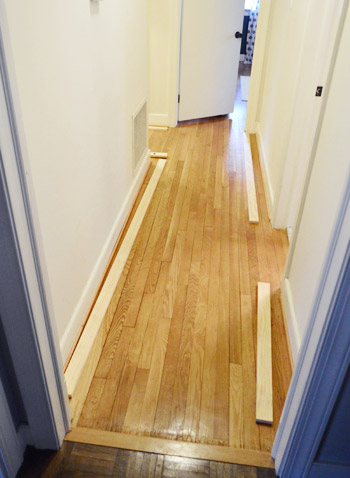
Before attaching them to the wall, we had to do a few things – like deciding the height of our board and batten. We first assumed “the higher the better!” and held it just under our light switches and thermostat. But after stepping back, we realized the high placement was just making our eight foot ceilings look lower than they already are.
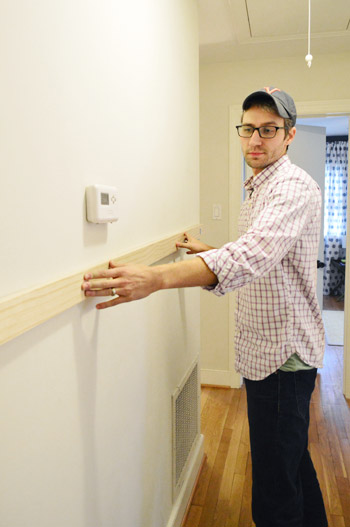
So, as you’ll see, we later landed on a more traditional height of 40″ off the floor, which is a lot closer to the “traditional range.” But again, many aspects of installing board and batten are just a personal preference thing, so go with whatever you think looks best for your space. I’m sure rooms with tall ceilings or ornate crown molding might look awesome with higher board and batten (as well as mudrooms and other entryway areas, etc).
Since floors and baseboards aren’t always level, we relied on this cheap laser level that I picked up a while ago to mark the 40″ line on a few spots along each wall. Those marks created a guide for us when holding our 1 x 3″ board in place.
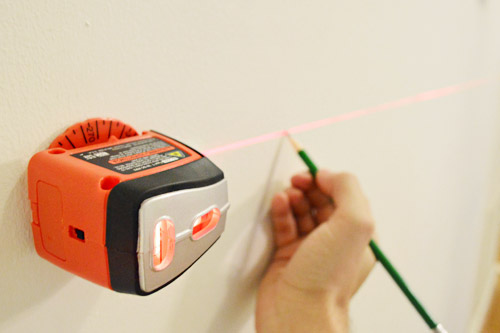
And since nails are always more secure when they go into studs, we also broke out our stud finder to mark each to-be-nailed spot along the wall. Obviously just remember to make your marks low enough that they won’t be covered when you hold up your top rail piece.
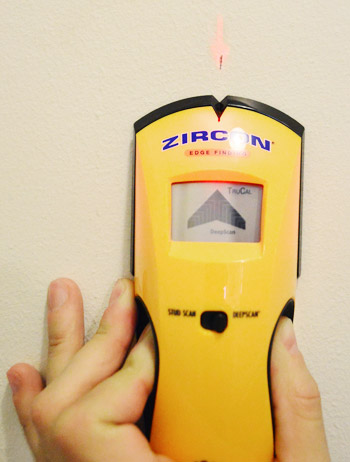
Next up was nailing the rails into place with my new pneumatic (i.e. air compressor powered) brad nail gun (the one photographed has been discontinued, but we switched to using this air-less nail gun anyways). This was my first time ever using one and it intimidated me the first few times, but now I’m in love with it (not as much as Sherry, who says she wants to marry it). I’ll write a separate post about it later, but let’s just say it was the saving grace of this project. It probably would’ve taken us three or four times as long to complete the construction portion of this project without it. We bought a pretty basic, but well-reviewed Craftsman model (here’s an affiliate link to it for ya).
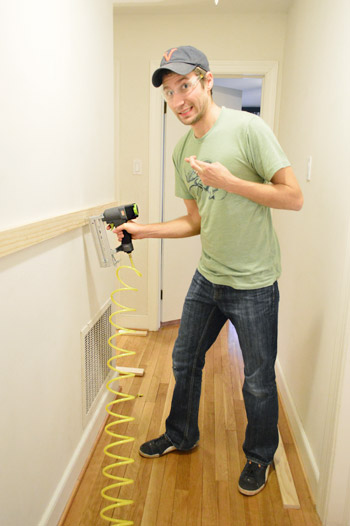
So here are all of the top rails in place. We opted not to glue them to the wall in addition to nailing them into studs simply because if we ever decide to remove or replace this, we don’t want to rip off chunks of drywall in the process. The good news is that the boards are so light – especially all of the vertical lattice pieces – that nails shot into studs with a nail gun are supremely secure… especially with the caulking that we did around any cracks to hold them even more firmly.
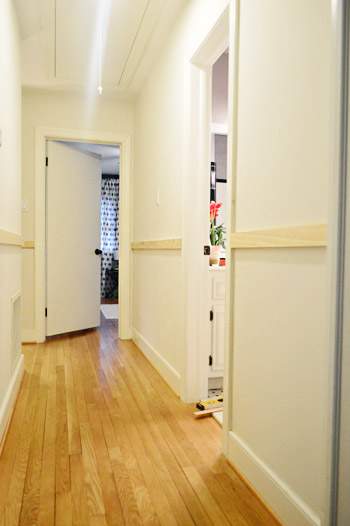
But even if you opted to glue things on top of nailing them, it wouldn’t add much time or cost to the project (a tube of Liquid Nails is just a few bucks). Speaking of time, if you subtract the time it took us to set up and figure out the nail gun, I’d say the process of measuring / cutting / nailing these took us about an hour.
Adding The Vertical Battens
We used lattice strips at Sarah and Emily’s suggestion because they were cheap (66 cents per foot!) and they didn’t stick out past our existing baseboard. Had we used 1 x 2″ boards like some folks do, it would’ve hung over our baseboards. We could’ve replaced our baseboards too, but then they would’ve stuck out past the trim around the four (count ’em four!) doors in our hallway. So yes, chunkier battens could be nice in less narrow spaces (we didn’t want ours to jut out too far and close things in) but in our case we actually thought the lattice + rail setup was ideal and we like the dimensional-but-not-crazy-thick result.
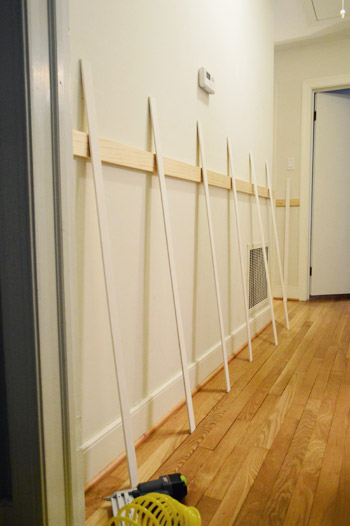
We chose to space our battens at 16″ intervals because our studs are 16″ apart and this meant that more nails would go into studs, not just into drywall. Plus, when we held up a few spacing options it looked pretty darn good (seriously, half of this project is just deciding what looks best and going with it). To make our lives easy, we used a scrap piece of 1 x 3″ board to make a spacer (a 14.5″ spacer kept the lattice 16″ apart from center to center).
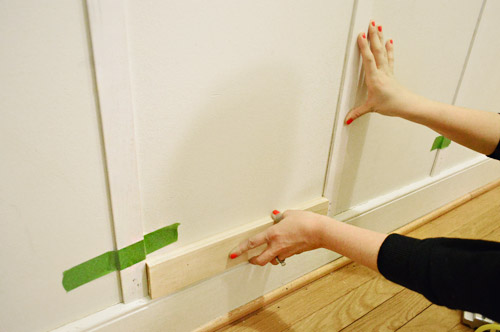
The lattice was light enough that tape held it to the wall while we used a level to make sure each batten was perfectly vertical. Then Sherry went back with the nail gun and secured them in place. Is it wrong to say that watching my lady concentrate so hard while wielding a power tool got me a little hot and bothered?
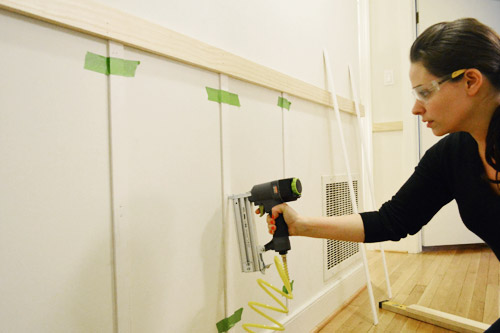
About an hour-ish later, all of the battens were cut to size and nailed into place.
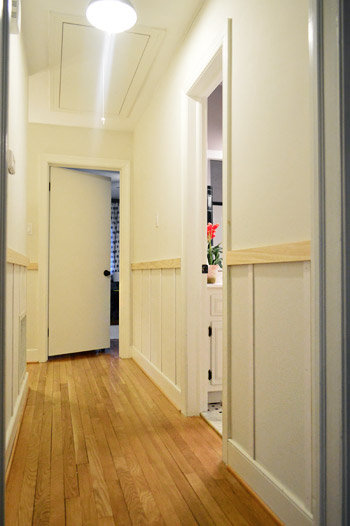
Since we wanted the batten on the facing walls to line up (and that’s where the studs were, which added stability), the placement was pretty easy to determine. But if you were tackling this and not every batten could end up in a stud to accomplish a balanced look, I’d go with balanced placement over hitting every stud (they’re seriously as heavy as a paint stirrer, so they’ll likely hold up fine either way).
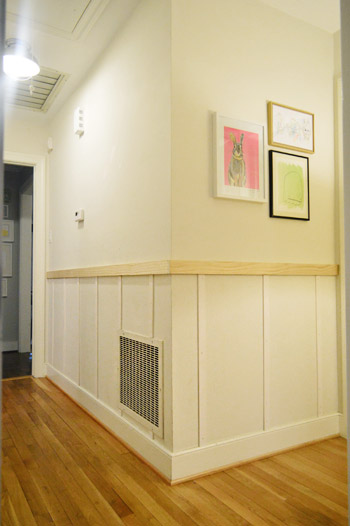
At around this stage of the project, Clara saw it for the first time – and here’s her reaction word for word: “Wow! It’s beautiful! Did a man come while I was sleeping and bring that?” Is that kid hilarious or what? She totally didn’t give us credit for it. We think it’s because that morning the heating guy came with an oil delivery for us, so she remembered a man coming to help with something and assumed he came back to fix up the hallway for us. Naturally.
Lots of the tutorials we saw included adding a ledge along the top to sort of beef things up or create a spot to lean art or other items. We bought some 1 x 2″ pine for this purpose but as soon as we held it in place we realized we didn’t really like it. Since it wasn’t going to be a functional ledge for us, it basically just narrowed the hallway more and created a few hazardous little corners for tiny heads to walk into. So we scrapped the idea, returned the wood, and enjoyed calling the construction phase: COMPLETE.

Prepare For Painting
The next day we started to prep the space for painting by filling nail holes and caulking gaps. At the recommendation of some of you guys, we went with spackle over wood putty (we hear joint compound works too) since it’s said to be easier to work with and holds up better over time. It certainly went on easier than wood filler so assuming it keeps looking as good as it looks right now, we’re completely sold on that approach for filling nail holes after your rails and battens are hung.
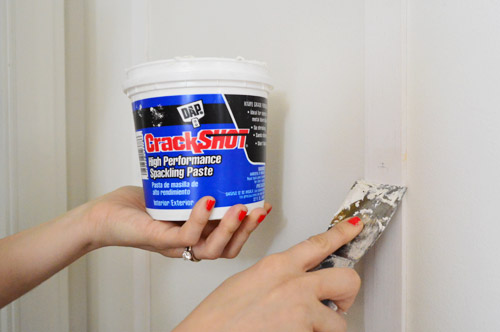
After all of the nail holes were spackled (not a fast process, but not too bad – maybe it took an hour total?) we used paintable white caulk to fill some of the gaps between our boards and the wall. Since our old house doesn’t have perfectly flat walls, this was a necessary step to keep the project looking nice and polished in the end. We didn’t do every edge, just the ones that needed it (across the top rail and a few places along the battens). I’d say the caulking step added another hour of work in case you’re wondering. Oh and definitely watch the finishing video in this post for more details about exactly what caulk we used, how I smoothed it, etc.
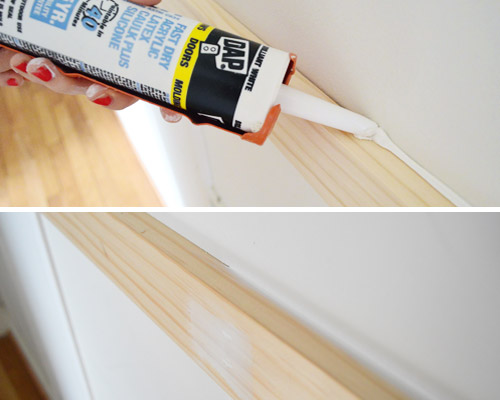
Later that day we broke out the palm sander to get rid of any excess spackle around the nail holes.
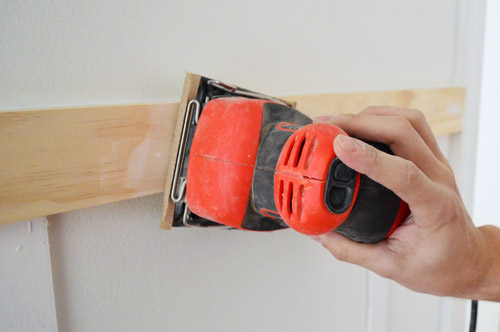
Prime & Paint
After that, the rails and battens were ready for primer. We already had Kilz Premium (which is a stainblocking primer) on hand, so we used a brush and a small foam roller to put one coat of primer on each piece of wood to prevent any bleed-through in the wood down the road (always a worthwhile “insurance” step). And we went over the battens too, just to be safe (even though they came pre-primed). Here’s the whole thing primed and almost ready for paint. Just had to let the primer dry.
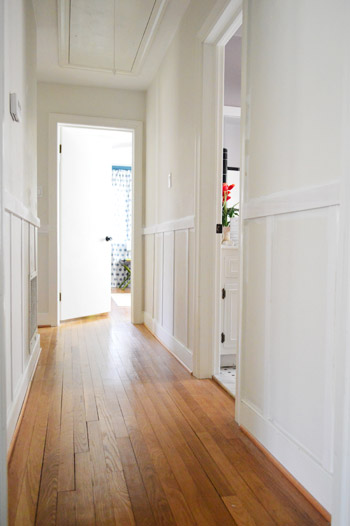
The next day it was finally time to paint the board and batten. We used Benjamin Moore Advance paint in Decorator’s White in a satin finish leftover from our office cabinet painting project. Advance paint is especially durable (we used it on our kitchen cabinets too) so we figured it was a good choice for hallway molding that might get its fair share of wear and tear.
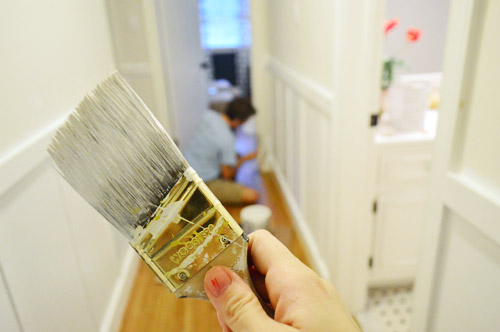
Admittedly, the finished picture of the painting step isn’t very dramatic since the walls above were still off-white.
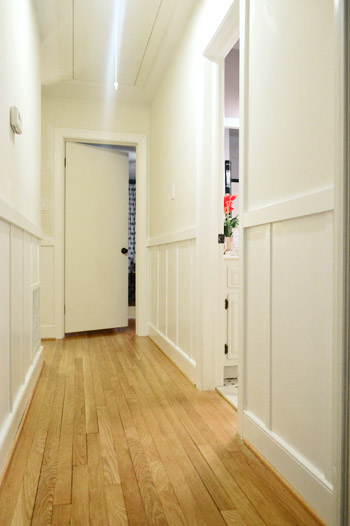
So after letting the paint cure for a couple of days we tackled painting the walls above the board and batten. Sherry was still nervous that taping the freshly-painted top rail could peel paint off, so she opted to cut in by hand around the top rails (you can read her tips for doing that here and watch the video in this post and the video here for even more tips). She did a great job, despite not having her usual short-handled brush handy.
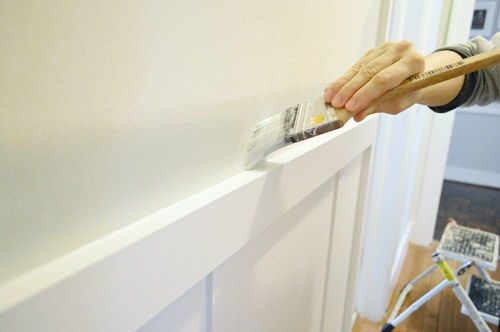
After she was done edging, I went back with the roller and (after a second coat) we had the finish line in sight.
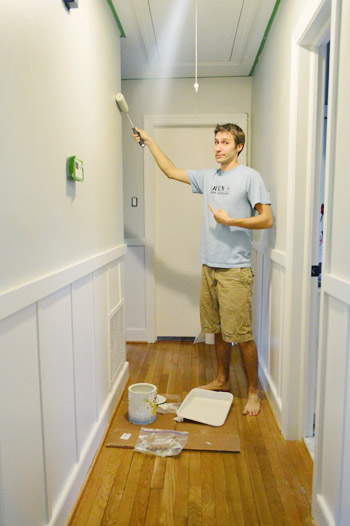
Oh, and if you couldn’t tell – we were painting the walls with Moonshine by Benjamin Moore since:
- we had some leftover from painting our dining room
- we didn’t want anything too bold/dark to close in the hallway
- it’s the color in the adjacent frame-filled hall and we wanted them to relate to each other (so things didn’t feel too choppy)
Note: we still have to paint the trim in the frame hallway the same white color as the board and batten.
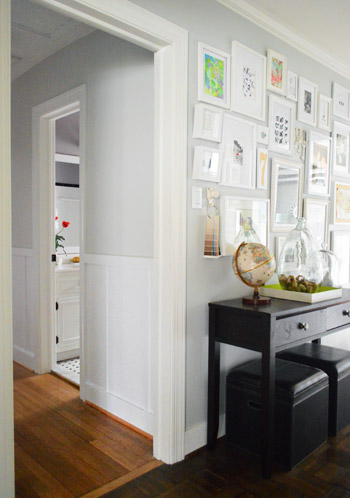
Boom. Just like that we’re ready for after pictures. So here we go!
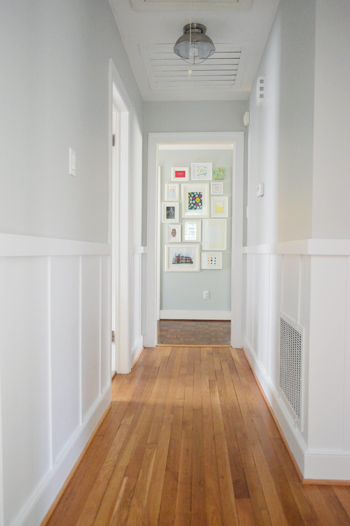
We’re in love with the result. And we’re kicking ourselves that we didn’t do it sooner. You know how you never quite realize how “blah” a space is until you do something to it and wonder why you waited so long? I mean, we walk through this hallway dozens of times a day and all we had done up to this point was hang some art in one small corner (the most hidden part of the hallway, ironically). But now that we’ve got the board and batten up we’re ready to hang some more.
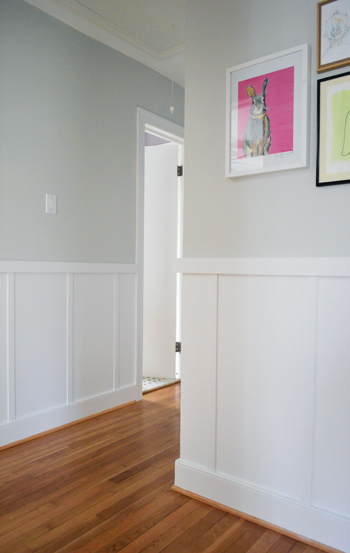
Total Project Cost
Okay, so let’s break down the budget. We only spent money on three items since we had things like paint, spackle, and caulk on hand. And had we actually purchased my nail gun back at my birthday in November as planned, our total cost for the project would’ve been only $57. Crazy, right?!
- Four 12′ pieces of lattice – $32 ($0.66/foot at Home Depot)
- Two 8′ pieces and two 6ft pieces of 1 x 3″ pine – $25 (also from Home Depot)
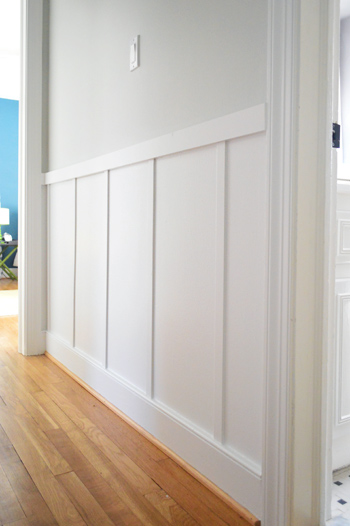
And time-wise, our project stretched over the course of five days (six if you count the trip to Home Depot for the materials). But if we had the luxury of not having to schedule things around Clara, it probably could’ve been completed in three days (first day for construction & spackling/caulking, second day for sanding/priming/painting the board and batten, third day for painting the wall). Heck, you could probably even ditch that third day if you’re doing this project on an already painted wall.
But if you’re doing the nailing by hand it might take longer (which explains why Sherry had the urge to make out with our nail gun). Oh but if you don’t want to buy one, you can always rent one from your local home improvement store, so that’s another option.
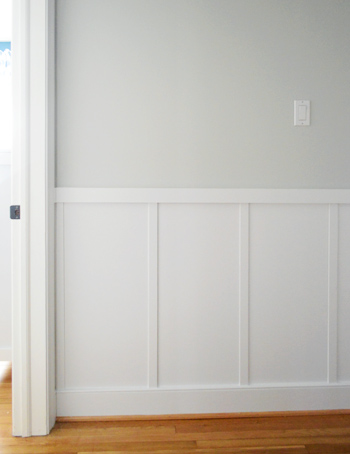
But here we are, roughly six days later and waaaay more excited to walk down our hallway. We’re now in the midst of figuring out what to hang on the walls above the board and batten, as well as choosing what next project we can take on to satisfy the itch I’ve now got on my nail gun trigger finger (after I wrestle it away from Sherry). I smell some crown molding in our future…
UPDATE: We repeated this project in our new house, but with a twist to make it feel a little bit fancier. Check out the tutorial for our new twist on classic board & batten here.
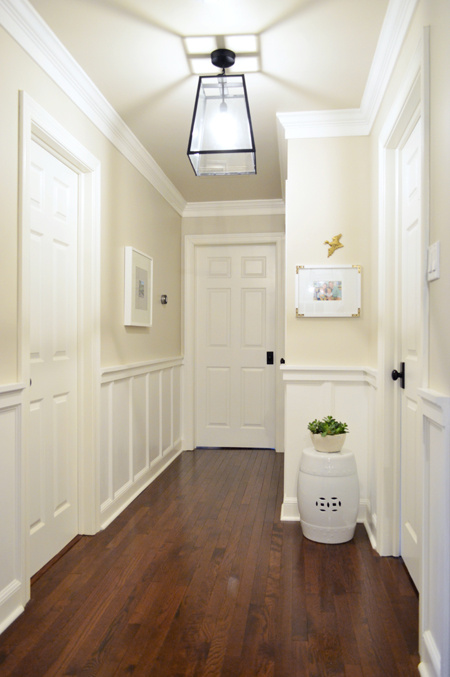
Update – Wanna know where we got something in our house or what paint colors we used? Just click on this button:


Taina Cunningham says
Guys this is GENIUS!!! I would love to do this in my mother in laws house. It would look amazing in her living room. Thanks for the DIY instructions. Now just to convince her to make the much needed update.:)
YoungHouseLove says
Aw, you’re welcome Taina! Good luck!
xo
s
Courtney says
Love, love, love it!!! This turned out so good and the tutorial is great. I’ve read other blogs for steps on this, but they always seemed to overwhelm me. This made board and batten seem totally doable.
Can’t wait to tackle this project at our house.
Thais Bessa says
It is beautiful!!!!
I have a silly parenting question: did you do all this nailing, banging, sanding right outside of Clara’s room whilst she was sleeping??? Man, if she slept through that I am very impressed! :)
YoungHouseLove says
The girl is a sleep champ! She can’t fall asleep when there’s banging, so we hold off while she goes down for her nap, but after she’s sleeping we’re good to go! I think she’s so used to sleeping through hammering and barking (both of those things go on insanely regularly around here) that it just works for her.
xo
s
Blair says
I’m curious about how you kept the spacing around the corner, and when you came to things like the vent on your wall. And tips for situations like that?
YoungHouseLove says
We just kept the spacing consistent (and followed the studs) so when they intersected the grate we just cut the area out where the grate sits and nailed them in at those increments on top and bottom of the grate so it all looked as seamless as possible.
xo
s
Carole says
Looks really great. Would you say that this would make a hallway look larger/narrow or shorter? Which type of hallways to you recommend this for?
YoungHouseLove says
Our hallway is only 40″ wide, which we think is pretty narrow but we think it opens things up and makes it feel wider! Sort of like how thick bands of horizontal color on a dress or shirt can make a person look wider? Haha! I would think this could work in nearly every hallway. Hope it helps!
xo
s
Ashley@AttemptsAtDomestication says
I absolutely love it! It looks fantastic! I really want to do this in our house, but we have really nice (and super expensive) 8 inch wood trim in our house, so now white trim for us.
Don’t get me wrong, I love the natural wood trim, it just makes me sad when I can’t have crisp white board and batten haha.
YoungHouseLove says
Aw man, maybe check if there’s any wood board & batten around and add some of that? Could be really pretty!
xo
s
Donna Jean says
It looks great! I was wondering how wide your hallway is? i would love to do this in our hall, but I’m afraid it might be too narrow.
YoungHouseLove says
It’s 40″, so fairly narrow I think!
xo
s
Laurie says
Thanks for the videos. I’ve been measuring my walls and ready to dive in and didn’t even think of a laser level. How much easier is that?! I like the lattice too. Saves money so you have more for the shelf and moulding if you want to go that route. I had heard about leaving the wood in your house for a few days beforehand because I have been thinking about planking my living room ceiling too. I have beams just like yours with a swirly 80’s ceiling in between them. Yuck!
heather says
I really like that you chose the same color as the hallway for this little hall too. It ties in together nicely and yet the white B&B makes it still feel like a different, albeit complementary, area. I also enjoy a good B&B (both the breakfast kind and the batten kind) and a nice solid light grey so I might be partial in thinking this is a nice look.
We just started painting our addition last night (eek! We’re finally painting!) and I already really like the color we chose. I even put up a “tutorial” on my blog on how to chose a paint color. Maybe it’s slightly sarcastic.
YoungHouseLove says
Haha! Off to check it out…
xo
s
Kari says
Love it!! We actually JUST finished putting up board and batten in our little eating nook (it’s about 7’x7′), and we have been thrilled with the results! One of the things that surprised us was how big it made the space look! It looks fantastic in a hallway, too, though – maybe it will have to find its way into our next house. Well done!
Sarah J. says
so great! i like how you can do something like this to make a very bland house into something architecturally interesting and beautiful! thanks for the step by step directions.
Krista says
So glad to hear you didn’t use glue! I recently removed a chair rail and baseboards from my dining room where glue was used. It ripped large chunks of paint and drywall which meant lots of plastering (and even more sanding because I am not very proficient at plastering!)
I am thinking of doing this int my hall and stairwell to break thinks up but I am not sure how it should look over stairs and I am certain it would double the work!
YoungHouseLove says
Oh no! So sorry about that glue fiasco Krista! Sounds like lots of hard work.
xo
s
Kristin M says
I’m a little surprised to see you guys don’t put down anything to protect/cover the floor while painting the walls. Is that the norm or an exception?
YoungHouseLove says
Oh yeah, we’ve just been painting regularly for 6+ years, so we’re crazy and we don’t use drop cloths on wood floors (you can easily wipe up a splatter when it’s wet or even “pop” it off when it’s dry). We wouldn’t do this over carpeting, but over wood it works for us :)
xo
s
Marbella says
Looks fab! I love our nail gun too. One tip I have for those looking to buy tools is check Craigslist before you buy – you can often find good, well taken care of tools for much less than new as people often buy things, use them once or twice then realise they don’t need them. We got our nail gun and compressor for $20 that way. I just picked up a new (used about twice) reel mower that I was about to spend $200 on at Lowes for half that price. Sometimes it means driving a few miles, but we often work it in with a trip that had to be run or get to visit a new area.
Always worthwhile checking the CL!
YoungHouseLove says
So smart!
xo
s
Kati says
This looks so great! I have a question though, for if I ever try to tackle this. Your walls look super smooth in the pictures. Is there much texture to them? Even if they aren’t textured, would this project look the same if there was texture to the walls? I feel like every house I’ve ever lived in has had super textured walls. I feel like it would take away from the board-look. Thanks guys! Keep up the awesome work!
YoungHouseLove says
Oh yes, if you click the link to Kate’s project that we included in this post, she did it on textured walls, so she has lots of tips for ya!
xo
s
Alison@soiledrotten says
This looks amazing! Great job!
Brenda says
There’s just something so classy about white board & batten. Love it!
Michelle says
I love the look! I’m wondering if it doesn’t feel sort of “out of the blue” though? Why not carry it through the frame hallway also?
YoungHouseLove says
There wouldn’t be a natural stopping point since the frame hallway leads into the living room, so we love that there’s trim at the end of the board & batten hallway to cut it off (and once we hang frames down the board & batten hallway it’ll relate even more to the frame hall along with being painted the same color :)
xo
s
Mafalda says
Hi everyone!
At this point I’m planning all the renovation I want do to in my house… And you’re an inspiration!
I didn’t know what to do in a hallway I have back at the bedroom’s area, because it’s very long but it’s narrow, so I can not put any furniture… It’s very naked! So I love this idea, hope my husband does too! Do you think that this option it will look good if I put in all the hallways???? I just have 2… It’s an apartment!!!!
I think you’ll hear from me more often! Hahahaha!
Love from Portugal
Kisses
YoungHouseLove says
Oh yes, I think it would look gorgeous! Good luck Mafalda!
xo
s
Kelli @ Little Cottage of Mine says
Ca-lassy guys! You’re hallway has on its fancy pants! I love it! The tutorial was really great, thanks! I’m gonna need you guys to do it down some stairs next so I can know how to do that too! I’ve got one boring hall going down to our basement.
Kelli
YoungHouseLove says
Haha! Fancy pants are my favorite kind of pants.
xo
s
Stacey @ Likes to Smile says
Wow! The side by side before and after photos really show the impact of this project. I cannot believe how much character those boards added to the hallway. It’s remarkable!
YoungHouseLove says
Aw thanks Stacey! We’re even more shocked in person- it really is one of the biggest bangs for our bucks that we’ve ever gotten!
xo
s
Morgan says
This is a phenomenal tutorial. I have been dying to do this since I saw this done at my friend Ryan’s house. Now that you have given such a great tutorial, I am going to get crackin. My big question though, I am planning on just accenting the dining area in my living/dining room. But now that I am seeing this, would it just be better to extend this throughout the room? Thoughts?
a-casual-list-of-home-improvements-where-was-i-now
Morgan says
http://livingywf.com/2013/02/27/a-casual-list-of-home-improvements-where-was-i-now/
Woops
YoungHouseLove says
Ooh I think it could look lovely either way! Throughout the room would be amazing if you’re up for it!
xo
s
Kathleen says
Loved this post. What motivated you to wait to prime the rails after you nailed them in? My first instinct would have been to prime them before. I’m assuming since it’s an indoor project it doesn’t make too much of a difference. Just curious!
YoungHouseLove says
It could totally go either way, but in our case it was nice to put them in place and then prime them instead of having to create another area in the house to lay them all out and prime them (we got to work within one “messy zone” and then clean that once the project was done instead of spreading it out all over the house – haha!
xo
s
Christina @ Homemade Ocean says
I beyond love it!
Our hallway needs a little love as well…hmmmmmm ;)
Holly Marie says
It looks SOOOOOOOOOOOOOOOOOOOOOOOOO good! And I love the timing of it because we literally just finished painting our guest room and had decided to do board and batten on the lower half (replacing the existing chair rail!) So now we have your tutorial to go off of too!
Anja says
This is so great! In my last home we had the cutest board and batten in mint green in our kitchen, and even though I was kind of shocked by the color at first, it became my absolutely favorite room. Now, sans board and batten, I find myself thinking about making some. This tutorial might be the well-deserved kick in the patoot so I get up and actually make it! ;-)
Amie says
You mean all this time y’all didn’t have an air nailer? Oh wow! You’re projects are really going to fly now!
Thanks for the link to the air nailer, I’ve added it to my registry ;). I used to use one all the time in high school at my parents for 4-H Woodworking projects, and for some reason I forgot all about it, or thought a little setup would be too expensive. The Evolv line looks like it gets decent reviews.
Have fun (not) hammering away!
YoungHouseLove says
I know, right? John built an entire deck and reno’d our first bathroom all without an air nailer! Insanity!
xo
s
karen says
hey guys…i’m not commenting for you to publish this…not to be creepy..but i think your address is on the cardboard box…on the painting vid. JUST telling you incase you aren’t aware of that. Maybe you don’t care… anyways..i love the video’s..so helpful!!
YoungHouseLove says
Aw thanks so much for the heads up Karen! That’s actually our PO Box, so thankfully it’s ok to see in the background there :)
xo
s
Mary says
It looks great. I’d say it’s more of a ‘batten’ job or ‘faux board and batten’, but I guess if you consider the top rail the ‘board’.
I recently did bead board in a small bathroom and it wasn’t that cheap so that’s great you can skip the ‘board’ part. My walls are all textured.
It’s interesting that battens are used to hide/seal board joints but the look is so cute we can put battens up right over an un-jointed wall and it looks upgraded!
Sadie says
I love this way too much!!We did the same thing on the wall going upstairs in our old house and it made it look so much richer and more custom. I hope you guys start adding tons of awesome millwork everywhere. Am I the only one who gets super excited about this stuff?! :)
YoungHouseLove says
Haha! Nope, you’re not alone!
xo
s
ashley @ sunnysideshlee.com says
i love it! seems like an easy enough project to add some zest to your hallway! Yes, I said zest! As in Zest fully clean! :)
YoungHouseLove says
Haha!
xo
s
Misty says
Honestly. What did take ya so long…? ;)
I cannot get over how amazing this looks!! It gives me butterflies! I am sending it to my boyfriend’s email right now! He is gonna hate me….. because i’m totally adding a project to his list! Ha!
Carra says
Love the results! I also noticed that the hallway light has been changed and it looks great :)
YoungHouseLove says
Oh yes, we have more little hallway updates to fill you guys in on (just had to get to the board & batten stuff first since it was “due” for the Pinterest challenge!).
xo
s
Mary says
Wow, that is the best $57 you’ve ever spent. Love it and I especially like the lattice, not all of us have huge homes and lattice is a great substitution. You guys ROCK!
Thanks for the inspriation.
McKenzie says
I have always wanted to do this!! But, I live in Alaska and for some reason every wall here has texture on it. I just don’t think it would look right. I’ll just have to wait until we build! Looks great. :)
Koliti says
What a FANTASTIC space changer! A lot of “BANG” for not a lot of buck.
Added bonus is if you want to hang something a little heavier on the walls you’ll know where all the studs are located just by using the location of the battens.
And Sherry, talking about finding studs…
John is a handsome man, but in his glasses he is VERY handsome.
YoungHouseLove says
Hah, it’s true about the glasses and about easily finding the studs. Love it!
xo
s
Melly says
What a beautiful job you’ve done. I can’t wait to watch videos when I get home because I am convinced that I need to do this in my own hall way.
A question about the nail gun . . . does the $70.00 include the compressor? I’m sure I could go online to HD and find out myself but, thought I’d ask you anyway.
YoungHouseLove says
Yes! It’s awesome and it’s all included! We hear the hose isn’t the best for that model but everything else is and a hose is inexpensive and easy to replace :)
xo
s
Melly says
That’s totally affordable. I know what I’m buying this weekend!
KENDRA says
Someone probably already asked this, but what did you do with the large vent on the wall? Paint it the same color? Spray or regular?
YoungHouseLove says
Yup, just painted it while we had the roller and brush out the same way as the trim and the walls.
xo
s
Megan @ Rappsody in Rooms says
Wow! This is a really thorough tutorial! Thanks for making it seem so easy. I am really itching to do this in our hallway now!
Sarah says
Nice job guys! I like that you didn’t add the ledge at the top – I agree that it would’ve looked too cramped in your narrow hallway. The photo of the look-back into the frame hallway really shows how gorgeous this all looks!
Sarah
P.S. nice glasses John!
Lisa @ Charlie The Cavalier says
Love it! Now you put the idea in my head. And not that expensive either. With a one year old running around, I almost need this to keep it clean.
Stephanie says
Wow, you really had me fooled. From how clean the pictures look, I really thought you had put a board behind the lattice. I can’t believe it’s just paint! I understand now why you can do this method with non-textured walls. Our walls are textured, but I would love to see this in the hallway from our garage to the living room (it’s the only hallway we have). Great job!
Amelia says
It looks fantastic! Now I’m thinking of places I could do this…!
The only question I had was how you handled the corner? I couldn’t really see from the photos (did you miter it or just caulk it up?).
YoungHouseLove says
We actually didn’t miter it and just used caulk since it butted up nice and tight after we nailed it all in! Looks nice and seamless now!
xo
s
Theresa says
Did you use the Advance paint on the walls as well? Considering this for a bathroom.
PS Love your house and all the colors. Got a sample of Moonshine for said bathroom, reads green there. Funny how paint works.
YoungHouseLove says
We just used the Moonshine we had already (in Natura, which is also nice for coverage and durability as well as bring no VOC).
xo
s
carla says
Looks great. This has been on my list for a long time too for my bowling alley of a hallway – have been waffling between b&b and more traditional wainscoting, but the b&b seems so much easier and probably cheaper. Love the use of lattice to get around the skimpy baseboards without replacing (yours are nice, mine are the builder basic skinny ones).
Melissa says
Love it! It really knocks the whole hallway up a notch and for so cheap so thats awesome too. When we finally do buy again this is definitely on my list of to dos. :)
xoxo,
Melissa
Jessica says
I have a question. You mentioned that you leveled the top rail with a level as opposed to using the floor or baseboard as a guide. My house is very old (early 1900s) and the floors in some places are not level at all–would it be better to: 1) have the top rail actually level (using a level) but appear not level compared to the floor/baseboards or 2) measure from the baseboards/floor so that the rail is parallel with them but not actually level? Maybe in an old crooked house, it is better not to do anything like this that might draw attention to the uneven lines! Thank you!
YoungHouseLove says
Hmm, I would meet in the middle I think. I bet if you go right between being “level with the floor” and “actually level” it might appear to all be nice and balanced. Here’s hoping!
xo
s
Kiki says
This looks amazing, especially as a super thrifty makeover! I’d love to do this, but I live in a rental right now, boo. You guys always make me look forward to owning a house one day :)
YoungHouseLove says
Aw thanks Kiki!
xo
s
Val says
Nailed it! *bahahaha*
So stoked about your new toy, too. Every time I show my husband projects on your site, he says, “That man needs a nail gun, stat!” He’ll be so happy for you.
YoungHouseLove says
Hahaha!
xo
s